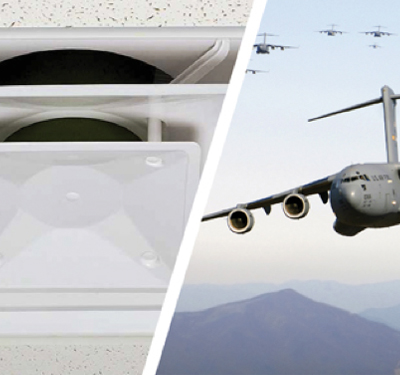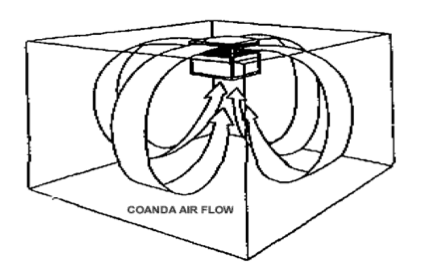

Coandă Effect Causes Ceiling Smudging
Posted in Facility Operations
Recently, we received a phone call from a maintenance staff member concerned about “dirt” building up around ceiling air diffusers in the common area of his mall. This is an interesting and common problem. The solution has two parts.
Part One
Engineers select diffusers with initial leaving air velocity and terminal velocity in mind. Careful selection of the diffuser minimizes dumping of cold air straight down, which can create drafts and air noise.
When the airflow leaves the diffuser it produces a lowpressure area between the diffuser surface and the ceiling that causes the air to “cling” to the ceiling. HVAC and diffuser engineers call this the Coandă Effect. The same basic principal is at work on the wings of airplanes and here is called “lift”.
This wave of air from the diffuser that’s being pushed across the ceiling causes room air to move with it and creates a large circular pattern initially following the air leaving the diffuser. As the air travels further from the diffuser, the air velocity drops, gradually causing the air pattern to lose its “cling”. It then falls toward the floor. This results in good mixing of the cool or warm air from the diffuser with the room air, but also results in the room air being pulled up toward the center of the diffuser.
Part Two
Ceiling smudging comes from two sources: primary air and room air dirt particles.
The primary air stream starts at the air conditioner. Outside air is introduced and mixed with the return air. This mixed air is filtered, and then the evaporator coil cools it. When the unit’s air filters aren’t efficient, they don’t remove air borne dirt. The air borne dirt becomes deposited on the coil, is carried through the supply ductwork, and exits through the diffuser, causing ceiling smudging. The secondary and most common cause of smudging is from room air. Dirt particles (dust) in the room become entrained in the air circulation created by the diffusers and are drawn to the ceiling by the creation of a the low velocity pocket discussed earlier (see: Coandă Effect). Some of the dirt in the air stream will be deposited on the ceiling as a smudge. Examples of where this is visable is in high traffic areas, high volume retail spaces, copy rooms, smoking lounges and of course in or adjacent to manufacturing plants.
Practice good housekeeping and periodically vacuum the ceiling to reduce smudging. For more dependable guidance, contact TES Engineering.


 Previous STORY
Previous STORY